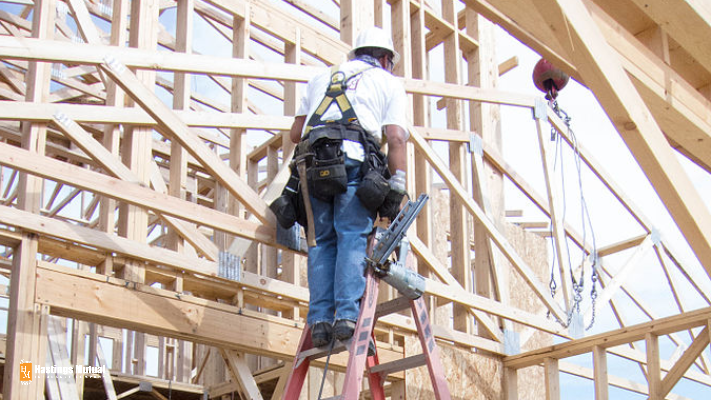Secure your future today!
What Everyone Can Do To Make Their Job Safer
The fundamentals of Job Hazard Analysis and how it can help your business.
A big part of insurance isn’t simply putting together an insurance policy or trying to make a sale. It’s reducing risk. If you’re driving safely, using appliances in your house by following the manufacturer’s instructions, and keeping your surroundings clean, there is less of a chance you’ll start a fire or get in an accident. We give you lots of valuable information on ways you can keep your home, business, and farm safe.
When you’re at work, there’s another easy tool you can use to make sure you’re doing things safely. A job hazard analysis (JHA) breaks jobs into distinct tasks to spot potential risks in each one. Here’s an example.
Task: Working with power tools.
Hazards: Cuts, abrasive, electric shock, injury from flying debris, tripping over power cords.
Recommendations: Keep tools in good condition. Inspect tools before use. Wear safety glasses. Work away from yourself.
Task
The exact kind of work that’s taking place. “Power tools” can be almost any kind of device, since all of them call for the same kind of caution.
Hazards
What could happen if something goes wrong, and why it’s important to reduce your risk when performing that task.
Recommendations
None of these suggestions are especially difficult or expensive. Both the Hastings website and OSHA have more ideas on ways to reduce your risks.

How to get started
It can be a little overwhelming to create a JHA for everyone and every task in your workplace. You don’t have to do it all at once. Instead, you can begin with the riskiest tasks, and add more later if you need to.
Start with the jobs that have the most risk — where there’s the highest chance for injury or the ones that are the most physically and mentally demanding. This might be:
- Falling from a rooftop, ladder, or other heights
- Being struck by falling material
- Materials handling
- Equipment and tool operation
Manufacturers also have other tasks with an element of risk, like:
- Safe machine operation
- Lockout practices
- Tool use
A JHA For Your Work Site
Breaking down a job into individual parts might seem simple, but if you’ve been working a job for a while there are probably things you’re so used to doing that you don’t even think about them any longer.
Try to split the job into individual tasks. Each time a worker uses a different kind of machine, that’s its own task. Different processes, like moving heavy objects or climbing ladders, are their own tasks too.
Next, go step by step through each task and identify what’s at risk. For example, a power tool:
- First needs to be plugged in.
- Then safety goggles and other protective equipment needs to be worn.
- The cut, drill hole, or whatever other work is being done has to be completed.
- The tool has to be removed from the working area and shut off, if not fully unplugged.
But wait! Before the tool is in use, the line that needs to be cut or the hole that needs to be drilled has to be measured (measure twice, cut once, as the old saying goes). See what I mean about breaking everything down into individual tasks?
It’s unlikely that there’s a lot of safety risk in using a pencil to draw a line, but part of a job hazard analysis is making sure every step of the process gets attention. So it’s important to identify what those steps are.
Once you have the tasks listed, look at each one and make recommendations on ways to do it safely. This can be anything from “inspect the machine for any leaks or broken parts” to “use the manufacturer’s guidelines to perform each action correctly.”
How to use your JHAs
When your JHAs are complete, let everyone know. Share them with your existing employees for a refresher, especially if managers notice that safe work practices are slipping. It’s also a great time for a review when there’s an incident that could have been avoided by using the information in a JHA.
New employees should receive training on appropriate JHAs as part of their orientation, so they have clear instructions in their new job, and so they understand safety expectations. JHAs and best practices for safe work that are clearly described are a part of standard operating procedures for many successful businesses. It’s a great way to show employees that safety is as important as quality and production.
Finally, keep JHAs somewhere everyone can find them. As I said before, when you’ve been on a job for a while it’s easy to take parts of the job for granted and develop shortcuts for yourself. A JHA can help keep people working on the right tasks in a safe way.
The Mutual Understanding blog and Hastings Mutual videos are made available for educational purposes only. The information referred to is not an official company statement, corporate policy, or offer of coverage. Refer to your insurance policy for specific coverage. There is no representation as to the accuracy or completeness of any information found by following any link on this site. Please contact your local independent insurance agent with further questions and for more details on any insurance policy-related information you read here.
© 2021 Hastings Mutual Insurance Company. All rights reserved.
Related Blog Posts
-
 Planning And Protecting Your Contracting Business
Planning And Protecting Your Contracting Business
You might not be on the job site, but you can prepare for a busy and safe summer now.
-
 Remaking Business For Older Workers
Remaking Business For Older Workers
It might not be time for retirement, but it is time to reassess your skills.
-
 The Value Of Experienced Employees
The Value Of Experienced Employees
There’s a lot of benefit to institutional knowledge, and a few simple ways to take advantage of it.
Secure your future today!
Hastings Insurance Company
404 E. Woodlawn Ave.
Hastings, MI 49058
Monday-Friday
8:00 a.m. - 4:30 p.m. (EST)
(800) 442-8277
Terms of Use and Privacy Statement© Hastings Insurance Company. All rights reserved.



